 “I've been poor and I've been rich, and rich is better.”
“I've been poor and I've been rich, and rich is better.”
|
|
|
 Bessie Smith Bessie Smith
(1894-1937)
— Blues singer nicknamed the “Empress of the Blues,” highest paid African American entertainer �of the 1920s
By Bob Hilson
When the record industry labeled Bessie Smith the “Empress of the Blues” in the 1920s, she accepted the moniker but held higher ambitions.
With her sulky but elegant contralto voice, hypnotizing delivery and unpretentious stage presence, Smith had already sold millions of records worldwide and was the highest paid African American entertainer at the time.
But while she knew her voice was her key to fame, she aspired to delve into other venues of the entertainment industry, mainly acting.
“I’m thankful, but I’m hopeful, too,” she said in early 1920s interview. “I’m still getting to where I want to go. It’s a long road, but I’m going to find the end.”
With songs like “Nobody Knows When You’re Down and Out,” “Empty Bed Blues” and “Backwater Blues,” and singing alongside musical stalwarts Bennie Goodman, Louis Armstrong and Lonnie Johnson, Smith commanded as much as $2,000 a week for her performances in the early to mid-1920s.
One of her hits, “Downhearted Blues,” was an immediate hit when released in 1923, selling more than 750,000 copies. Another hit, “St. Louis Blues,” in which she again teamed with Louis Armstrong, is considered to be one of the best recordings of the 1920s.
But her theatrical aspirations never materialized. She performed in one movie and had a role in a Broadway production that critics called “mediocre at best.”
Never stop singing
Smith returned to singing full-time in the late 1920s, proudly proclaiming “the greatest blues singer in the world will never stop singing.” However, the Great Depression hit in 1929 and severely damaged the music industry’s ability to sell records.
(Ironically, Smith’s most popular song, “Nobody Knows When You’re Down and Out,” was released in September of 1929; the stock market crashed two weeks later.)
Although she still performed in small venues, Smith was unable to get a contract with a recording label. In 1933, she recorded for the last time.
“I've been poor and I've been rich, and rich is better,” she later lamented.
Born in Chattanooga, Tenn. in 1894, Smith sang and danced as a child on street corners for loose change while accompanied on the guitar by her brother, Andrew. The duo performed in the heart of the African American community in Chattanooga and made as much as $15 a day.
In 1904, when Smith was 10, her oldest brother, Clarence, left home to join a small travelling troupe. He returned two years and arranged an audition for his sister with the troupe’s managers as a dancer rather than a singer. The troupe already had a headliner in Ma Rainey, who was an established recording star and appeared in clubs nationwide.
Although talented, Smith’s private and public image was considered “rough” and not gentile enough for all audiences. In fact, once during an audition for a record label, Smith stunned onlookers by stopping in mid-song to spit on the floor. Smith seemed perplexed by their reaction and continued singing.
Smith died in a car accident in Clarksdale, Miss., in 1937 at age 43. She was buried in Philadelphia.
The inspiration for countless female vocalists over the  decades, including Billie Holliday, Aretha Franklin and Janis Joplin, Smith’s grave remined unmarked for 33 years, when Joplin helped pay for a tombstone in 1970. It reads: “The greatest blues singer in the world will never stop singing.” decades, including Billie Holliday, Aretha Franklin and Janis Joplin, Smith’s grave remined unmarked for 33 years, when Joplin helped pay for a tombstone in 1970. It reads: “The greatest blues singer in the world will never stop singing.” |











